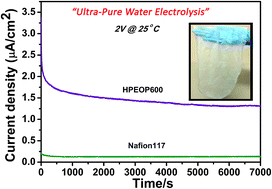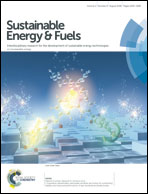On the development of a proton conducting solid polymer electrolyte using poly(ethylene oxide)†
Abstract
By mimicking the polymer backbone assisted ‘hop and lock’ lithium ion transport in lithium solid polymer (SP) electrolytes, a new type of proton (H+) transport membrane cum separator is designed which is found to work even in pure water electrolysis. An inexpensive H+ transporting SP membrane (HPEOP) is formulated using perchloric acid (HClO4) as the proton source with a poly(ethylene oxide) (PEO) and polydimethylsiloxane blend as the host structure. The H+ coordinated PEO backbone via the solvation of HClO4 allows easy transport of H+ through PEO segmental motion and inter-segmental hopping. Humidity dependent ionic conductivity measurements on the optimized HPEOP membrane show higher values in comparison to those of Nafion 117, and a considerable ionic conductivity was shown by HPEOP even in an anhydrous environment (3.165 ± 0.007 mS cm−1) unlike Nafion 117 (∼10−7 mS cm−1). Lowering the melting temperature of PEO through HClO4 ‘salting in’ is found to have a considerable effect in enhancing the conductivity of this SP membrane, while addition of HClO4 also modifies the microstructure and mechanical strength of the membrane. Water electrolysis ‘H’ cells are constructed with both pure and protonated water using both HPEOP and Nafion separators (membranes), and studies show the possibilities of highly efficient low cost water electrolysis and fuel cells devoid of expensive Nafion membranes.



 Please wait while we load your content...
Please wait while we load your content...